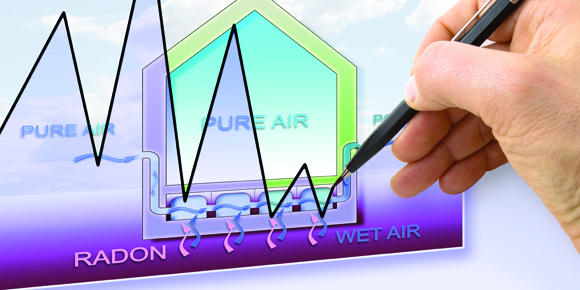by Todd Lewys
It’s something that may be lurking in your basement, but you don’t know it’s there because it can’t be seen, smelled or tasted.
That “something” is radon, a radioactive gas that’s produced naturally by the breakdown of uranium in the soil and rock that comprises the ground surrounding your home. And while it doesn’t pose a threat to your health in diluted outdoor air, it’s an altogether different story indoors where the gas can become concentrated and pose a significant health threat.
Here’s what happens when you breath in radon gas: once inhaled, it breaks down into alpha particles. Those particles release small bursts of energy which are absorbed by lung tissue. This absorption results in either lung cell death, or damage to lung cells.
When damaged, lung cells can potentially turn into cancer cells when they reproduce. Long-term exposure to high levels of radon can cause this to happen. Every year, 3,200 Canadians die from lung cancer that can be attributed to long-term radon exposure.
If you’re a smoker and are exposed to radon — which can enter a home through cracks in foundation walls and/or floor slabs, construction joints, gaps around service pipes and support posts, floor drains and/or sump pits and wall cavities — your chances of getting lung cancer are one-in-three (smokers still stand a one-in-10 chance of suffering from lung cancer even if they’re not exposed to radon).
The chance of non-smokers exposed to radon is still a scary one-in-20.
Consequently, it’s important that you have your home tested to see what the radon levels in the basement and all other levels, said Pinchin Limited’s (Mississauga, Ontario) national lead on radon testing, Scott Cryer.
“The only way to know what radon levels in your home are is to conduct a test,” he said. “It’s a very important thing to do, as radon levels can change hour-to-hour, day-to-day and month-to-month. There’s usually a greater concentration of radon in homes during the heating season, which typically takes place from October to April, so that’s when the testing should be done.”
Cryer added that the testing needs to be conducted over a period of 90 days.
“If the testing period is shorter than that, it’s too easy to get a false-positive or false-negative reading. Doing the test over a three-month period gives you a more accurate reading and a far better indication of what the radon level might be in your home.”
Should a 90-day test indicate that radon levels in your home are dangerous, there’s no need to panic, as there’s a clear-cut remedy for the problem.
“Sub-slab depressurization systems can be installed in residential dwellings fairly easily,” Cryer said. “Such systems involve putting a pipe through the basement floor. That pipe is then hooked up to a fan that blows the air out a side wall, or the roof. It runs 24 hours, seven days a week, and is very effective. It changes the pressure, and does an excellent job of removing radon-heavy air from homes. It’s also a very energy-efficient system.”
What if my home already has an HRV (Heat Recovery Ventilator) installed with the furnace?
“They’re only about 50-per-cent efficient compared to a sub-slab depressurization system,” he explained. “The only way to make sure you’re properly evacuating radon gas from you home is to get one of those systems installed.”
The cost of sub-slab systems isn’t all that prohibitive, said Cryer.
“Cost for a system typically runs between $2,500 and $5,000. The cost of the system increases if you have to route the pipe through a crawl space, or if it takes extensive work to put the pipe up through the roof so it exhausts the radon gas properly. Even if the cost is $5,000, it’s a worthwhile investment.”
In other words, both the radon test — and possibly a sub-slab depressurization system — are investments that will safeguard the health of your entire family.
“It (testing) is something that’s really important to do,” he said, adding that do-it-yourself testing kits are also available at various stores, such as Home Depot. “There are so many people who’ve never smoked who’ve gotten lung cancer who may have gotten it from radon exposure. It’s better to be safe than sorry.”



